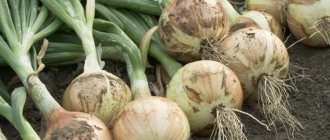Why do you need a garter?
Raspberries are an undemanding plant, but without timely implementation of a number of agrotechnical techniques, the bush can produce a lot of young shoots, which leads to crushing of the berries and a decrease in yield.
Garter is one of the essential elements of caring for aromatic berries.
- It provides the following advantages:
- reduces the risk of infection by fungi and pests;
- creates favorable conditions for the growth of young shoots;
- protects heavy fruiting branches from damage;
- accelerates the ovary and ripening of berries due to uniform illumination of all branches by the sun;
- facilitates maintenance (feeding, watering, loosening);
- allows you to insulate the bushes before the onset of cold weather;
- provides convenience and reduction of injuries (in case of thorny shoots) during berry picking.
With timely and correct gartering of raspberries, you can avoid many problems associated with the health of the plant and get a rich harvest of tasty berries.
Learn about the advantages and disadvantages of replanting raspberries in spring and fall.
In what cases is it not required?
Not all raspberries need staking.
Certain varieties bear fruit regardless of how their shoots are positioned:
- Varieties with erect, thick, stable shoots (for example, Polyana, Polka, Gusar, Senator). They form very sparse shoots and do not fall under the weight of the crop.
- Dwarf varieties due to their short stature and resistance to diseases and parasites (such as Credo, Inaccessible).
When to carry out
Beginning gardeners, faced with growing raspberries for the first time, often wonder when exactly they need to tie up shoots in a raspberry garden and how to do it correctly.
Depending on the purpose, gartering is carried out twice a year: in early spring and late autumn. Spring garter helps prevent the plant from being damaged by pests and diseases, simplifies the care and collection of berries, and ensures abundant fruiting. In the fall, the procedure helps increase the chances of raspberries surviving the winter.
Find out how to properly prepare raspberries for winter.
Seasonal features of the procedure
Spring gartering is carried out in early spring, when the night temperature rises above 0°C and the top layer of soil dries out a little.
First of all, a two-stage pruning is carried out: the first time after the snow has just melted, and the second time after the buds open and dry shoots and shoots that have already borne fruit are clearly visible. Next, proceed directly to gartering using any of the selected methods.
Winter garter is necessary to prepare the bush for the cold period. To do this, a wire is pulled between the bushes at a distance of approximately 0.25 m from the ground. The shoots of the plant are bent to this wire and secured using synthetic ropes. In winter, snow cover will protect the branches from severe frosts.
Did you know? It is believed that the first raspberry garden was created by Yuri Dolgoruky. The garden was so large that bears and other animals lived in it.
How to tie raspberries to a trellis?
With the advent of new tools and materials, caring for berry gardens is becoming easier. The most important task, how to properly tie raspberries to a trellis, is performed in several ways:
- Application of tapener
. The tool is a garden stapler, which speeds up the tying of shrubs significantly. The stems are covered with soft tape and fixed to the wire. When you release the handle, the tapener automatically cuts the tape and is again ready for the next job. The disadvantage of this method is the expensive cost of the tool, but over large areas it pays off. - Raspberry garter with flexible wire in a sheath
. First, one end of the garter material of the required length (8-10 cm) is wrapped around a horizontal thread of the trellis. Then they draw a wire around the shoot and fix the plant. - Using simple twine
. The garter is carried out using a figure of eight. First, fix the twine to the wire, and then wrap the rope around the shoot.
The variety of methods, their pros and cons
There are many ways to garter raspberry bushes, each of which has its own advantages and disadvantages.
- The stake method of tying is characterized by:
- simplicity of the process;
- low cost of materials used.
- However, it also has some disadvantages:
- uneven illumination of shoots by the sun;
- not all ovaries develop evenly;
- increased risk of fungal infection;
- possible injury to shoots during harvesting.
The trellis method is more complex.
It allows:
- young shoots grow freely;
- uniformly illuminate the maximum number of branches;
- ensure air circulation throughout the entire height of the bush;
- harvest without discomfort.
The disadvantages of this method are the complexity and duration of bush formation.
The fan method provides free air circulation and access to the sun to young shoots , but is not very popular among gardeners.
To choose the most convenient way to secure branches, you must first study the features of each of them.
Find out when and how to prune raspberries correctly.
Kolova
This method is also called beam method. It consists of the following: a stake is driven into the center of the bush . Its length depends on the height of the bush - it should exceed the length of the branches by 0.4–0.5 m. On average, two-meter stakes or slats are used.
When tying, from 5 to 7 branches need to be picked up around a support to a height of 120 to 150 cm. The central and upper mass of branches are tied into a bundle and tied to a stake, and the upper part of the bush is pulled to the side to form a semicircle and also secured.
Did you know? Despite their sweet taste, raspberries are considered a low-calorie berry. Due to the high content of essential oils, minerals and biologically active substances, it is recommended to be included in many diets.
Various poles and metal pipes can be used as a stake.
Materials for making trellises
If you make high-quality structures, they will serve for many years. It is preferable to make supporting racks from metal pipes, pre-treating them with an anti-corrosion compound, such as paint or bitumen mastic.
Wooden supports are less durable and can also be treated with antiseptic impregnations. The wire must be strong, preferably stainless steel.
A braided metal cord in a propylene sheath is also suitable. In order to make a trellis with your own hands, you will need various tools.
If the trellis is metal T, V or Y-shaped, you need a welding machine, grinder, and tape measure. To build a wooden structure you will need a hacksaw, a screwdriver, and self-tapping screws.
Trellis
Trellising is a fairly progressive method, thanks to which you can double the yield of raspberries. A trellis consists of stakes driven into the ground at a certain distance, between which a wire is stretched.
On trellises, unlike individual stakes, garters can be made using several methods, each of which will be considered separately.
Single garter
Provides a specific scheme for constructing trellises:
- The supports should be deepened into the ground by 0.5 m. The pillars should have a height of more than 2 m.
- You need to start installing the supports with supports first, then the remaining supports.
- The step between the pillars should be 4 m.
- Between the supports, stretch the wire in 3 rows to a height of 1.65 m, 1.05 m and 0.75 m from the ground level.
- Secure the wire to the posts with special brackets or bolts.
- Tie the branches of the bushes in such a way that each shoot is located separately.
- Advantage of the method:
- uniform sun illumination of each shoot;
- sufficient ventilation of the bush;
- convenience when picking berries.
The disadvantage is the need to tie each branch in all rows, since if there is no tie in the bottom row, the shoots may break during harvesting.
It will also be useful for you to know what you can’t plant raspberries with.
Double
Technology for constructing trellises for double garter:
- Dig two-meter supports to a depth of 0.5 m at a distance of 4 m.
- Stretch a wire between the supports at levels of 1 m and 1.5 m from the ground.
- Tie the shoulder straps in 2 places, then separate them in different directions, securing them at a distance of 0.5 m.
- Advantages:
- increase in harvest volumes due to increased growth of young shoots;
- increasing the degree of illumination of each branch.
The disadvantage is that branches are injured during harvesting.
Scandinavian
Install the supports in the same way as for a double garter. A special feature is the height of tension of the top wire - instead of 1.5 m, it should be placed at a height of 2 m. The branches should not be tied, but wrapped in a V-shape around the wire.
- Advantages of the method:
- improved branch ventilation;
- making berry picking easier;
- better growth of young shoulder straps;
- It is easy to notice the beginning of damage to the bush by diseases or pests.
The downside is possible defects that can affect raspberry bushes with this method of tying.
Familiarize yourself with the features of feeding raspberries for a good harvest.
Mobile turnstile
The movable turnstile is the most complex design for gartering raspberries , but it is interesting and significantly speeds up the collection of berries. It allows you to give the shoots the maximum amount of sun.
With the help of such a turnstile, you can change the position of the supports from vertical to horizontal , and the crossbars with fixed branches can change the orientation by 120°.
Purpose and advantages of raspberry trellis
Varietal raspberries, which are grown by modern gardeners, grow to a height of more than one and a half meters. It also grows long lateral shoots with their own berries. The fruits of these varieties are quite large, and under their weight the branches break, unable to withstand the load. To prevent this from happening, gardeners use plant staking. An excellent option would be to make a trellis.
Important! It is recommended to make trellises in raspberry fields, the bushes of which are planted in rows. If the raspberries are planted chaotically, then separately driven supports are used for them.
Most often, raspberry supports are used in large areas. It has a number of advantages:
- the lower growth does not fall to the ground;
- the berries do not get dirty in the ground after precipitation;
- the plant is well blown with fresh air, which is an excellent prevention of fungal diseases;
- Raspberries are evenly illuminated by the sun's rays, due to which they ripen at the same time.
Similar designs are suitable for both raspberries and grapevines. Thanks to strong trellises, raspberries are easy to care for:
- carry out sanitary pruning of bushes;
- water and mulch the root zone;
- harvest from raspberries;
- prepare raspberry bushes for wintering.
Raspberry supports are very convenient structures that can be made once and used for several years.
fan garter
For a fan garter, you need to drive two-meter stakes between the seedlings. Visually divide each bush into 2 parts, one of which is tied to the right stake, and the second to the adjacent (left).
Thus, part of one bush and part of another are tied to each support, due to which the bushes become like a fan, hence the name of the garter method.
Single support
The most popular garter scheme , in which 2 pairs of two-meter supports are installed at a distance of 3 m. Between the supports you need to stretch 2 (or 3) rows of wire.
Fruiting shoots should be tied to the wire, each separately. Unlike other methods, here the upper part of the shoot remains free. When the top grows above 0.2 m above the top wire, it must be bent and tied.
Important! For tensioning, it is better to use wire made of lightweight materials to prevent increased load on the supports. It should also be remembered that the heavier the material for tying, the smaller the step between the supports should be.
What materials are best to use
The purpose of the garter is to increase the yield of raspberries while reducing the time and labor required to care for them. Therefore, before proceeding with the construction of structures for this agricultural technique, it is necessary to select the right materials.
Basic requirements for materials for tying plants:
- The surface of the material should not slip, since in windy weather it can cause damage to the raspberry stems.
- The material should not oxidize or rust.
- Materials such as fishing line, steel or copper should only be used with insulation as they can scratch and cut branches.
- Preference is given to lightweight and flexible means. Steel and galvanized wires are not used.
- Resistance to chemical solutions guarantees a long service life of the structure.
Trellis, stakes, pillars. Load-bearing structures can be made of wood, reinforced concrete, metal.
Their thickness can be any, and the height for support from any material ranges from 1.8–2.5 m. Wire for garter. As a material for tensioning between the supports, you can use either new plastic wire or improvised means. They will help significantly save on construction costs.
- Special wire for garters made of plastic or polyester is a priority. This material is soft enough not to injure the shoots. The disadvantage is that the stems slip in strong winds, but this problem can be easily solved by securing the shoots with clip holders.
- Installation galvanized cable. The optimal diameter is 2.2–4 mm. Very comfortable, no slipping of branches. However, it is susceptible to rust, which can damage the plant, so it is not recommended to remove the insulation from it.
Height and other dimensions of the raspberry trellis
Many novice gardeners are interested in how high the trellis should be so that it can easily withstand gusts of wind and the weight of ripe berries. The most optimal would be a trellis, the height of which is from one and a half to two and a half meters.
Important! In order for the support to stand stably on the site, the pillars must be made 80 centimeters longer than the expected height. This is how far the supports will need to be deepened into the soil.
The pillars are placed at a distance from 75 centimeters to 3 meters. How to install a supporting structure is determined based on:
- the reliability of the pillars, which is determined by their thickness and height;
- how long the rows will be;
- type of garter stems;
- wire strength.
Each raspberry stem needs to be fixed in two places.
Is it possible to grow raspberries without a garter?
Some varieties of raspberries can be grown without the use of a garter. These include the following: Shy, Balsam, Coral, Bulgarian Ruby.
Important! Without a garter, you can grow raspberry varieties that have thick stems and grow no higher than 1.5 m
However, in order to get a good harvest, it is necessary to take into account a number of features of caring for raspberry bushes.
- The planting area should not be very large. The optimal width is 0.5–0.7 m.
- In the first year, the sprouts do not require thinning or other similar agricultural practices.
- In the second year, it is necessary to remove sprouts that extend beyond the designated area (raspberries should not grow densely).
- In spring, it is mandatory to thin out the bushes so that all the shoots are well illuminated by the sun, there is sufficient air access, and the berries ripen faster and are not crushed.
Whether there is a need to garter the bushes depends on the raspberry variety.
For the most part, this crop requires the installation of supports and fastening of branches, which prevents their mechanical damage, damage by diseases and pests, and also facilitates care and harvesting. Properly carried out garter can guarantee a rich harvest of aromatic berries. There are a sufficient number of ways to secure raspberries, and every gardener will find the most acceptable and convenient one for himself.
What are trellises for?
If the raspberry bushes are not supported on supports, they will spread along the ground, where high humidity can serve as a source of bacterial diseases, which will lead to the loss of part of the harvest. Gartering raspberries on a trellis will protect against the negative effects of wind and precipitation.
Even rows of raspberries tied on trellises give the area a well-groomed appearance, and the plants receive more solar energy, which helps to increase the number of fruits. In this case, it is easier for the gardener to care for the plantings by fertilizing, watering and pruning.
Picking berries is easier since there is access to the bushes from different sides. Raspberry stems will not break in gusts of wind, the berries will dry quickly after rain, and will be less susceptible to damage by insects and pests.
To make it easier for himself in the future, the gardener needs to try to arrange the bushes as evenly as possible when planting, so that later it will be more convenient to tie them up.











